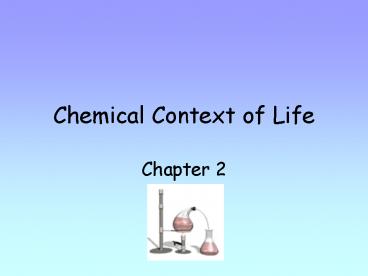Chemical Context of Life - PowerPoint PPT Presentation
1 / 27
Title:
Chemical Context of Life
Description:
Chemical Context of Life Chapter 2 Matter - anything that takes up space, has mass. Element - substance cannot be broken down by chemical reaction (i.e. copper ... – PowerPoint PPT presentation
Number of Views:155
Avg rating:3.0/5.0
Title: Chemical Context of Life
1
Chemical Context of Life
- Chapter 2
2
- Matter - anything that takes up space, has mass.
- Element - substance cannot be broken down by
chemical reaction (i.e. copper) - Represented by a symbol (Cu)
3
http//www.dmturner.org/Teacher/Pictures/Matter.gi
f
4
- Compound - consists of 2 elements combined in
fixed ratio. - 92 natural elements, 25 essential.
- Carbon, oxygen, nitrogen, hydrogen, phosphorus,
sulfur included.
5
http//attrasoft.com/imagefinder60/image_abm60_12_
12.jpg
6
- Atom - smallest unit of matter still has
properties of original element. - Composed of subatomic particles.
- Neutrons are neutral, protons positive charge,
and electrons negative charge.
7
http//serc.carleton.edu/images/usingdata/nasaimag
es/atom-with-electrons.gif
8
- Protons and neutrons - found in atomic nucleus
electrons orbit nucleus. - Atoms of one element have same number of protons
in nuclei (atomic number) - Protons and neutrons together - mass number.
9
Negative charge
Positive charge
Neutral charge
http//www.bartleby.com/images/A4images/A4atom.jpg
10
- Mass - atomic number of neutrons.
- Atomic weight - total mass of atom.
- Electrons weigh very little mass number is
approximation of atomic weight of atom.
11
http//www.bbc.co.uk/schools/gcsebitesize/img/gcse
chem_90.gif
12
Isotopes
- Isotopes - atoms of element have different
numbers of neutrons (different weights) - Element exists as mixture of isotopes.
- Radioactive isotope (carbon-14) - nucleus decays
spontaneously and gives off energy.
13
http//education.jlab.org/glossary/isotope.gif
14
Energy
- Energy - ability to do work.
- Potential energy - stored energy kinetic energy
- energy of motion. - Top of a hill, potential energy rolling down the
hill, kinetic energy. - Electrons change positions while orbiting nucleus.
15
http//www.glenbrook.k12.il.us/gbssci/phys/Class/e
nergy/u5l1b1.gif
16
- Positions around nucleus - electron shells or
energy levels. - Move away from the nucleus, energy levels
increase. - Electron absorbs energy as it moves away from
nucleus. - Gives off energy as moves closer to nucleus.
17
(No Transcript)
18
Bonding
- Atoms share or transfer atoms (bonding)
- Atoms held together by electrons they share or
transfer. - Covalent bonding - pair of electrons shared.
- 2 atoms held together by covalent bond
molecule.
19
http//www.cem.msu.edu/reusch/VirtTxtJml/Images/l
ewstrc1.gif
20
- Covalent bonds either polar or nonpolar.
- Electrons shared equally - nonpolar.
- Electrons closer to 1 atom polar (1 atom more
electronegative than other).
21
- Ionic bonds - 1 atom donates electrons to other
atom - form compounds (i.e. salt). - Ionic and covalent bonds - strong.
22
Sodium donates electron to chlorine.
- Ionic bond
23
Polar covalent bond electrons pulled closer
to oxygen.
- Polar bond
24
- There are weaker bonds that exist briefly.
- Hydrogen bonds form when H atom covalently bonds
to one atom but attracted to another atom. - Occurs mostly with O2 (like in water).
25
(No Transcript)
26
Reactions
- Chemical reaction - making and breaking of
chemical bonds. - Starting materials reactants ending materials
- products. - Concentration of reactants determines how fast or
slow reaction will go.
27
Rusting is an example of a chemical reaction
http//www.oxygenkiosk.net/php-cgi/d/135-2/A_Chemi
cal_reaction.jpg































